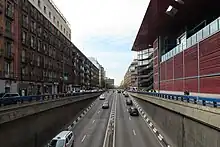Ronda de Atocha
The Ronda de Atocha is a thoroughfare in Madrid, Spain. It is part of the rim of streets rounding up the city historical centre, following the layout of the Walls of Philip IV.
 | |
| Type | public thoroughfare |
|---|---|
| Location | Madrid, Spain |
| East end | Plaza del Emperador Carlos V |
| West end | Ronda de Valencia |
History and description
Starting in the Plaza del Emperador Carlos V and ending in the Ronda de Valencia,[1] the ronda de Atocha conforms a stretch of the southern limits of the Centro district.[2] The Ronda occupies part of the layout of the ancient Walls of Philip IV.[3]
The ronda already existed when the map of Texeira (1656) was created.[4]
The area was refurbished during the reign of Charles III (late 18th century), and the Ronda de Atocha became part of a trident of forested boulevards (along the Paseo de las Delicias and the Paseo de Santa María de la Cabeza) that followed the patte d'oie configuration in vogue at the time.[5]
Following the end of the 1936–1939 Spanish Civil War, during the Francoist dictatorship, the name of the Ronda de Atocha was changed to "General Primo de Rivera",[6] in reference to Miguel Primo de Rivera. After 1968, the thoroughfare featured one of the three overpasses of so-called "scalextric" of Atocha, that infamously became one of the largest hotspots of air pollution in the entire city.[7][8]
On 25 January 1980, during the municipal government of Enrique Tierno Galván,[n. 1] the City Council voted in favour of returning the name of the thoroughfare back to "Ronda de Atocha" along a wider change of another 26 street names connected to the Francoist dictatorship or the Civil War.[9] Meanwhile, the dismantling of the "scalextric" started in 1985.[7] Works were completed in 1986.[10]
References
- Informational notes
- Although, convalescent from a retinal detachment repair, the Mayor could not attend to the voting and delegated the chairing of the plenary session to Ramón Tamames.[9] The Union of the Democratic Centre (UCD) opposed the proposed changes and submitted a full amendment. The initiative came through with the votes from the municipal councillors of the Spanish Socialist Workers' Party (PSOE) and the Communist Party of Spain (PCE).[9]
- Citations
- "Callejero Oficial del Ayuntamiento de Madrid" (PDF). Ayuntamiento de Madrid. 2015. p. 59.
- Alcolea Moratilla & García Alvarado 2002, p. 192.
- Domingo, Marta R. (7 June 2019). "Del Paleolítico a la era romana: los vestigios bajo la plaza de España". ABC.
- Peñasco de la Puente & Cambronero 1889, p. 87.
- "La memoria de la industria en el sur de Madrid". Madridiario. 9 July 2010.
- Montoliú 2005, p. 84.
- "El 'scalextric' de Atocha, el efímero héroe contra el tráfico". Madridiario. 16 May 2018.
- Valdés y González-Roldán 1970, p. 21.
- Ramírez, Daniel (13 February 2016). "La última vez que Madrid cambió sus calles franquistas". El Español.
- Miranda San Miguel 2017, p. 7.
- Bibliography
- Alcolea Moratilla, Miguel Ángel; García Alvarado, José María (2002). "El centro de Madrid en los ámbitos de la planificación urbana y de las acciones de protección" (PDF). Madrid: Revista de Arte, Geografía e Historia (5): 179–200. ISSN 1139-5362.
- Miranda San Miguel, Lorena (2017). El scalextric de Atocha (PDF). Universidad Politécnica de Madrid.
- Montoliú, Pedro (2005). Madrid en la Posguerra. Madrid: Sílex. ISBN 84-7737-159-8.
- Peñasco de la Puente, Hilario; Cambronero, Carlos (1889). Las calles de Madrid. Noticias, tradiciones y curiosidades. Madrid.
{{cite book}}: CS1 maint: location missing publisher (link) - Valdés y González-Roldán, Antonio (1970). "Pasos a desnivel en Madrid". Ciudad y Territorio. Estudios Territoriales (3): 19–26.